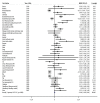Prediction of New-Onset and Recurrent Atrial Fibrillation by Complete Blood Count Tests: A Comprehensive Systematic Review with Meta-Analysis
- PMID: 28496093
- PMCID: PMC5439535
- DOI: 10.12659/msmbr.903320
Prediction of New-Onset and Recurrent Atrial Fibrillation by Complete Blood Count Tests: A Comprehensive Systematic Review with Meta-Analysis
Abstract
BACKGROUND Atrial fibrillation (AF) is one of the most critical and frequent arrhythmias precipitating morbidities and mortalities. The complete blood count (CBC) test is an important blood test in clinical practice and is routinely used in the workup of cardiovascular diseases. This systematic review with meta-analysis aimed to determine the strength of evidence for evaluating the association of hematological parameters in the CBC test with new-onset and recurrent AF. MATERIAL AND METHODS We conducted a meta-analysis of observational studies evaluating hematologic parameters in patients with new-onset AF and recurrent AF. A comprehensive subgroup analysis was performed to explore potential sources of heterogeneity. RESULTS The literature search of all major databases retrieved 2150 studies. After screening, 70 studies were analyzed in the meta-analysis on new-onset AF and 23 studies on recurrent AF. Pooled analysis on new-onset AF showed platelet count (PC) (weighted mean difference (WMD)=WMD of -26.39×10^9/L and p<0.001), mean platelet volume (MPV) (WMD=0.42 FL and p<0.001), white blood cell (WBC) (WMD=-0.005×10^9/L and p=0.83), neutrophil to lymphocyte ratio (NLR) (WMD=0.89 and p<0.001), and red blood cell distribution width (RDW) (WMD=0.61% and p<0.001) as associated factors. Pooled analysis on recurrent AF revealed PC (WMD=-2.71×109/L and p=0.59), WBC (WMD=0.20×10^9/L (95% CI: 0.08 to 0.32; p=0.002), NLR (WMD=0.37 and p<0.001), and RDW (WMD=0.28% and p<0.001). CONCLUSIONS Hematological parameters have significant ability to predict occurrence and recurrence of AF. Therefore, emphasizing the potential predictive role of hematological parameters for new-onset and recurrent AF, we recommend adding the CBC test to the diagnostic modalities of AF in clinical practice.
Figures








Similar articles
-
Haematological indices as predictors of atrial fibrillation following isolated coronary artery bypass grafting, valvular surgery, or combined procedures: a systematic review with meta-analysis.Kardiol Pol. 2018;76(1):107-118. doi: 10.5603/KP.a2017.0179. Epub 2017 Oct 5. Kardiol Pol. 2018. PMID: 28980298
-
Platelets Cellular and Functional Characteristics in Patients with Atrial Fibrillation: A Comprehensive Meta-Analysis and Systematic Review.Med Sci Monit Basic Res. 2017 Mar 17;23:58-86. doi: 10.12659/msmbr.902557. Med Sci Monit Basic Res. 2017. PMID: 28302997 Free PMC article.
-
Intravenous magnesium sulphate and sotalol for prevention of atrial fibrillation after coronary artery bypass surgery: a systematic review and economic evaluation.Health Technol Assess. 2008 Jun;12(28):iii-iv, ix-95. doi: 10.3310/hta12280. Health Technol Assess. 2008. PMID: 18547499
-
Screening strategies for atrial fibrillation: a systematic review and cost-effectiveness analysis.Health Technol Assess. 2017 May;21(29):1-236. doi: 10.3310/hta21290. Health Technol Assess. 2017. PMID: 28629510
-
Comparison of cellulose, modified cellulose and synthetic membranes in the haemodialysis of patients with end-stage renal disease.Cochrane Database Syst Rev. 2001;(3):CD003234. doi: 10.1002/14651858.CD003234. Cochrane Database Syst Rev. 2001. Update in: Cochrane Database Syst Rev. 2005 Jul 20;(3):CD003234. doi: 10.1002/14651858.CD003234.pub2. PMID: 11687058 Updated.
Cited by
-
Mean Platelet Volume Has Prognostic Value in Chronic Lymphocytic Leukemia.Cancer Manag Res. 2020 Oct 12;12:9977-9985. doi: 10.2147/CMAR.S246385. eCollection 2020. Cancer Manag Res. 2020. PMID: 33116854 Free PMC article.
-
Hematological parameters in atrial fibrillation: A literature review.World J Cardiol. 2025 Jul 26;17(7):108363. doi: 10.4330/wjc.v17.i7.108363. World J Cardiol. 2025. PMID: 40741025 Free PMC article. Review.
-
Red Cell Distribution Width as a Novel Marker for Different Types of Atrial Fibrillation in Low and High Altitude.Cardiol Res Pract. 2019 Mar 7;2019:6291964. doi: 10.1155/2019/6291964. eCollection 2019. Cardiol Res Pract. 2019. PMID: 30984423 Free PMC article.
-
Early Mortality of Brain Infarction Patients and Red Blood Cell Distribution Width.Brain Sci. 2020 Mar 26;10(4):196. doi: 10.3390/brainsci10040196. Brain Sci. 2020. PMID: 32224967 Free PMC article.
-
Association of Premature Ventricular Contraction (PVC) with hematological parameters: a data mining approach.Sci Rep. 2025 Jan 20;15(1):2514. doi: 10.1038/s41598-025-86557-z. Sci Rep. 2025. PMID: 39833257 Free PMC article.
References
-
- Macle L, Cairns J, Leblanc K, et al. 2016 Focused Update of the Canadian Cardiovascular Society Guidelines for the Management of Atrial Fibrillation. Can J Cardiol. 2016;32:1170–85. - PubMed
-
- Ali-Hassan-Sayegh S, Mirhosseini SJ, Rezaeisadrabadi M, et al. Antioxidant supplementations for prevention of atrial fibrillation after cardiac surgery: An updated comprehensive systematic review and meta-analysis of 23 randomized controlled trials. Interact Cardiovasc Thorac Surg. 2014;18:646–54. - PubMed
-
- Fuster V, Rydén LE, Cannom DS, et al. 2011 ACCF/AHA/HRS focused updates incorporated into the ACC/AHA/ESC 2006 Guidelines for the management of patients with atrial fibrillation: A report of the American College of Cardiology Foundation/American Heart Association Task Force on Practice Guidelines developed in partnership with the European Society of Cardiology and in collaboration with the European Heart Rhythm Association and the Heart Rhythm Society. J Am Coll Cardiol. 2011;57:e101–98. - PubMed
-
- Kornej J, Apostolakis S, Bollmann A, Lip GY. The emerging role of biomarkers in atrial fibrillation. Can J Cardiol. 2013;29:1181–93. - PubMed
-
- Varasteh-Ravan HR, Ali-Hassan-Sayegh S, Shokraneh S, et al. Relationship of admission mean platelet volume, platelet distribution width and white blood cells with ST resolution in patients with acute ST segment elevation myocardial infarction treated with streptokinase without history of previous cardiovascular surgery. Perspect Clin Res. 2013;4:125–29. - PMC - PubMed
Publication types
MeSH terms
LinkOut - more resources
Full Text Sources
Medical

